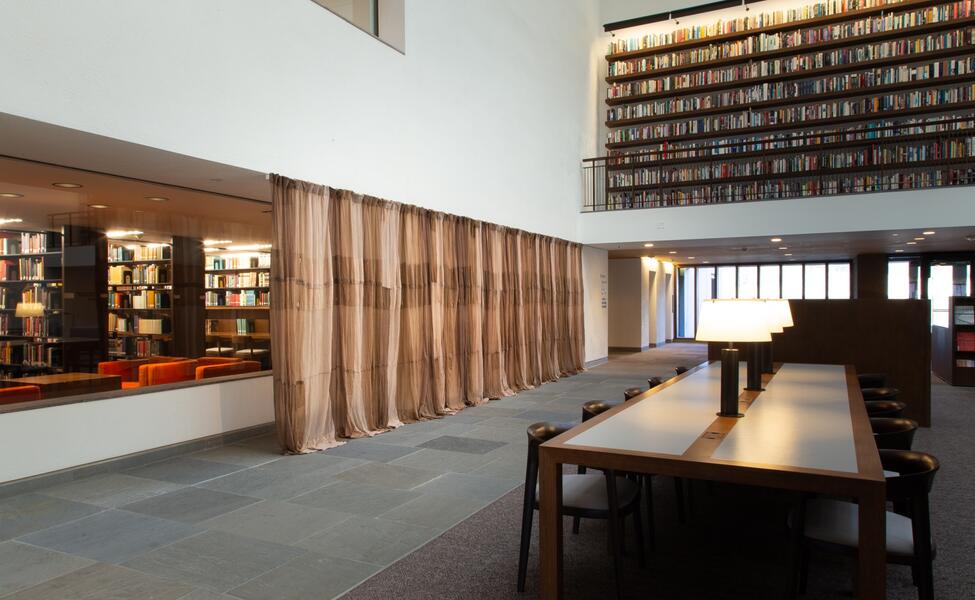PIA CAMIL - MEXICAN ARTIST - IN THE CLARK ART INSTITUTE OF MASSACHUSETTS
PIA CAMIL - MEXICAN ARTIST - IN THE CLARK ART INSTITUTE OF MASSACHUSETTS
The Clark Art Institute has launched a new program of year-long contemporary art exhibitions installed in its public spaces with an inaugural exhibition, Pia Camil: Velo Revelo, presenting three works by Pia Camil (Mexican, b. 1980).

The program includes a site-specific installation in the Manton Research Center Reading Room and two works presented in the lower level of the Clark Center. The exhibition title combines the Spanish words for “veil” and “to reveal,” suggesting Camil’s interest in the tensions between private and public, opaque and transparent, domestic and institutional. The exhibition of Camil’s work will be on view through January 2021 and is free and open to the public.
“Pia Camil is one of the most exciting artists working in Latin America today,” said Olivier Meslay, Hardymon Director at the Clark. “This is a wonderful collaboration that enlivens our public spaces and reminds visitors that the Clark is a place for the art of all ages, year-round.”
Robert Wiesenberger organized the exhibition for the Clark, working closely with Camil. “Pia Camil is the ideal artist to launch this program, given her sensitivity to architectural space, her deep engagement with art history, and the breadth of her cultural references,” said Wiesenberger, the associate curator of contemporary projects at the Clark. “Camil excels in many media, from ceramics to drawings to performance, but this selection shows visitors how she deals with one specific medium: using fabric alone, Camil creates works that are both beautiful and incisive, asking probing questions about craft, the body, gender, and identity.”
Camil used the sheer nylon of pantyhose to create Velo Revelo (2020), a more than fifty-foot-long curtain that partially covers both an internal window that looks into the Clark’s library and conceals a scale reproduction of a painting she selected from the Clark’s collection. The sculpture modifies the formal, public, and institutional architecture of the Manton Reading Room to evoke intimacy, domesticity, and femininity. For Camil, the range of skin-toned colors used in stockings also invites questions of identity and self-presentation. She chose Giovanni Boldini’s (Italian, 1842–1931) Young Woman Crocheting (1875), which depicts craft as leisure, to be seen through the curtain, as much for its focus on the subjectivity of the sitter as for the richly handled fabrics depicted surrounding her. The original painting is currently on view in the Clark’s permanent collection galleries.
-
Pia Camil (Mexican, b. 1980), Velo Revelo (detail), 2020. Nylon hosiery, photograph on board. Courtesy of the artist. © Pia Camil. Photo: Amy Coon
-
Pia Camil (Mexican, b. 1980), Telluride Tunic, 2015. Stitched fabric, installed: 84 1/2 x 105 x 3 3/4 in. Courtesy of the artist and Blum & Poe, Los Angeles/New York/Tokyo © Pia Camil. Photo: Art Evans
-
Pia Camil (Mexican, b. 1980), Valparaiso Green Cloak for Three, 2016. Stitched fabric, 81 1/4 x 175 in. installed. Courtesy of the artist and Blum & Poe, Los Angeles/New York/Tokyo © Pia Camil. Photo: Art Evans
-
Works by Pia Camil exhibited in the lower level of the Clark Center. Telluride Tunic, 2015 (left), Valparaiso Green Cloak for Three, 2016 (right). Courtesy of the artist and Blum & Poe, Los Angeles/New York/Tokyo © Pia Camil. Photo: Art Evans
-
Pia Camil (Mexican, b. 1980), Velo Revelo, 2020. Nylon hosiery, photograph on board. Courtesy of the artist. © Pia Camil. Photo: Amy Coon
Telluride Tunic (2015) and Valparaiso Green Cloak for Three (2016), sculptures from Camil’s “Skins” series, are presented in the lower level of the Clark Center. These monumental, garment-like forms, made of castoff fabric from textile factories, draw parallels between traditional Mexican craft and the modernist American paintings of Frank Stella. Telluride Tunic borrows its title and color from Frank Stella’s 1962 Telluride, a T-shaped canvas in his “Copper Paintings” series. Noting the similar shape and geometric patterning of Stella’s painting and garments like the poncho or serape, Camil reimagined Telluride in cloth. Similar to Telluride Tunic, Valparaiso Green Cloak for Three (2016) references the methodical geometry of Stella and traditional Mexican dress but adds colorful, seemingly painterly printing errors on the fabric as a gestural counterpoint to Stella’s matter-of-fact minimalism. Intentionally oversized to fit multiple people, it is also an object that implies a performance.
Research assistance for the project was provided by Mariana Fernandez, curatorial intern and graduate student in the Williams Graduate Program in the History of Art. Pia Camil’s work is courtesy of the artist and Blum & Poe, Los Angeles/New York/Tokyo.
Pia Camil lives and works in Mexico City, and studied at the Rhode Island School of Design and the Slade School of Fine Art in London. Her practice is research-driven and collaborative, and her mediarange from found and hand-dyed fabric to ceramics, video, and performance. Camil’s work was recently presented in solo exhibitions at the Guggenheim Museum, Queens Museum, Museo Universitario del Chopo, Nottingham Contemporary, and Contemporary Arts Center, Cincinnati
The Sterling and Francine Clark Art Institute
225 South St
01267 Williamstown, MA




